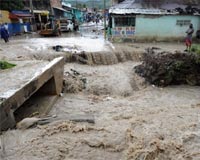| . |  |
. |
Ondangwa, Namibia (AFP) May 8, 2009 As flood waters in northern Namibia subside after nearly four months, residents are slowly repairing their homesteads, harvesting the few remaining crops and sending children back to school. "At first it was nice not having to go to school, because the floods prevented classes," 12-year-old Tangeni Shivute told AFP. "But I missed my teachers and being with the other children." He lives in a small village tucked behind newly woven grass walls and in the shade of tall palm trees characteristic of the flat, white-sanded plains around Ondangwa, just 70 kilometres (45 miles) from the Angola border. Schools are supposed to be on holiday now, but after floods forced closures across the region, thousands of students now sit in class to catch up during the break. "They must not fall behind with the curriculum and be up to date come June," regional education officer Adam Ngulu tells AFP. More than 200 schools were closed because they were surrounded by water or because young children were too small to walk across the huge flat pans -- locally known as oshanas -- filled with water one metre (three feet) deep. These shallow pans have no real river beds. As unusually heavy seasonal rains hit Namibia and neighbouring Angola earlier this year, the waters silently filled the oshanas. Once they were full, even more rain connected the oshanas to form vast shallow lakes stretching for kilometres and taking months to dry up. At least 102 people have died since January in the worst flooding since 1972, which has affected 600,000 people across northern Namibia. Namibia's government says it will cost about two billion Namibian dollars (240 million US dollars, 180 million euros) to clean up and repair infrastructure to prevent future disasters. "I have lost all my millet crop because the flood put my field under water for weeks," said Hileni Amunyela, a middle-aged widow living near one of the region's few main roads. "It is too late now to plough with my two oxen and plant again," she said as she looked over the blackened plant stalks that had only grown knee-high when the floods hit in February. Millet -- the staple food called mahangu -- is a traditional crop that the 600,000 Oshiwambo-speaking people, who populate this part of Namibia, brought with them when they settled here 400 years ago from the Great Lakes region, according to historians. Amunyela's neighbours are helping out with extra millet they managed to save from last year. "My two sons work in Windhoek and send me remittances every month, so I can buy up mahangu to feed me and my teenage daughter over the next months," she added. The government's latest damage estimate said 20,000 people lost 49,000 hectares of crops while some 9,000 livestock died. Nearly 82,000 people need food rations over the next months. Subsistence farmers find some solace watching their few cattle getting fat from the lush grass growing now, but others blame bad town planning and poor drainage for roads built across oshanas during dry years. "I grew up here in Ondangwa and the last big flood was in 1972 and again only in 2008, followed by this year's worse flood," said Johnny Ipinge, who works for a guesthouse here. "Now the population has grown. People build their shacks and brick houses anywhere, even in the middle of an oshana, not thinking of possible floods." Share This Article With Planet Earth
Related Links Bringing Order To A World Of Disasters When the Earth Quakes A world of storm and tempest
 15 dead, 70,000 homeless in Brazil floods
15 dead, 70,000 homeless in Brazil floodsRio De Janeiro (AFP) May 4, 2009 Severe flooding has hit Brazil's perennially drought-stricken northeast, killing 15 people and leaving 70,000 others homeless, authorities said Monday. The states most affected by the flooding are Maranhao, Piaui, Ceara, Alagoas and Bahia. Six people were killed and six major highways were inundated in Maranho, drenched by the heaviest rains since 1985, civil defense authorities said. ... read more |
|
| The content herein, unless otherwise known to be public domain, are Copyright 1995-2009 - SpaceDaily. AFP and UPI Wire Stories are copyright Agence France-Presse and United Press International. ESA Portal Reports are copyright European Space Agency. All NASA sourced material is public domain. Additional copyrights may apply in whole or part to other bona fide parties. Advertising does not imply endorsement,agreement or approval of any opinions, statements or information provided by SpaceDaily on any Web page published or hosted by SpaceDaily. Privacy Statement |